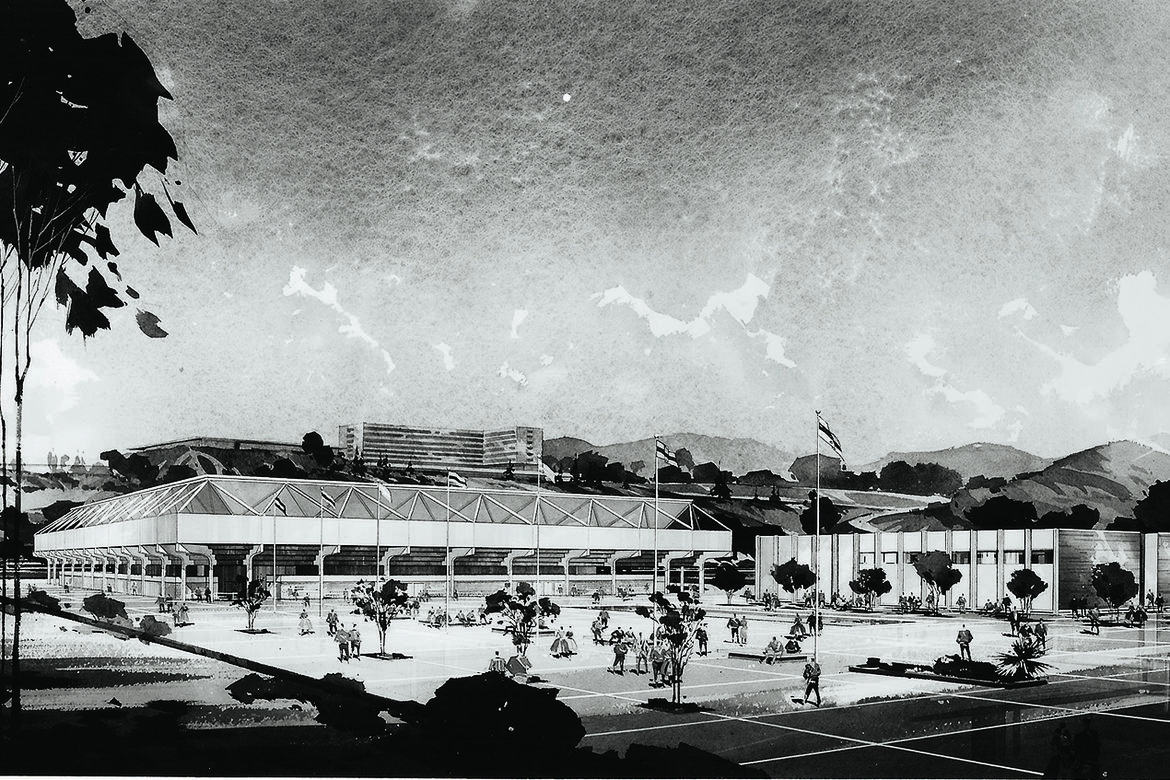The Cinerama Dome, Beverly Hilton, Dorothy Chandler Pavilion, Pan-Pacific Auditorium, Santa Monica Civic Auditorium and Theme Building at LAX, plus Century City, Cedars-Sinai and Capitol Records: All are Los Angeles icons, designed by the architectural firm of Welton Becket. In fact, Becket — whose firm eventually became one of the world’s largest — is credited with defining the very look of mid-20th-century L.A. And his vision extended to UCLA: Welton Becket and Associates designed Pauley Pavilion, Ackerman Student Union, Schoenberg Hall and the Center for the Health Sciences. In fact, the firm designed or supervised the design of close to 40 campus buildings in all, including residence halls and parking structures. Becket was also responsible for the look of UCLA neighbors Bullocks Westwood and the Federal Building.
A native of Seattle, Becket came to Los Angeles in 1933 and quickly gained notoriety when he and his partners designed the Streamline Moderne Pan-Pacific Auditorium. Much of the building, in L.A.’s Fairfax District, was destroyed by fire in 1989. On the heels of that award-winning work came residential commissions for such luminaries as James Cagney, Robert Montgomery and President Dwight D. Eisenhower.
Meanwhile, amid the unprecedented affluence following World War II, the California State Legislature had dedicated a portion of accumulated wartime taxes to construction, much of it for the development of the UC system. According to the Los Angeles Times, UCLA received “the largest single amount earmarked for any one campus in the history of American education.” In 1947, with this abundance of resources in hand, the UC Regents chose Becket’s firm to be the master planners of the UCLA campus, with Becket himself serving as supervising architect. At the same time, university officials had the arroyo that divided the campus filled in, making another 24 centralized acres available for building.
Becket’s charge from the regents was to develop a contemporary style. The logic was that minimalistic steel and brick buildings could be constructed more quickly and at a lower cost than buildings in the original style. So the man who would become known as “L.A.’s invisible builder” drew up a master plan and went to work, weaving Modernism into the Romanesque campus symbolized by stately Powell Library and Royce Hall.
“We had to get away from Romanesque,” Becket said, because the ornamental facades of UCLA’s early structures were too expensive and “the towers and cupolas … very inefficient and space-wasting.” He did continue to use the same basic building materials, but “in a completely modern way.”
The Center for the Health Sciences was one of Becket’s first campus projects. California Governor Earl Warren had signed a bill allotting $7 million for a medical school at UCLA, and the founding dean had urged the construction of a full-scale hospital to accompany the school. Becket’s plan called for one large complex to include the Neuropsychiatric Institute, School of Dentistry, School of Public Health, Marion Davies Children’s Clinic, Jules Stein Eye Institute and Reed Neurological Research Center. The complex would incorporate 12 miles of corridors. The budget was $15.5 million. Over the years, Becket’s firm continued adding wings and new buildings according to the master plan. The facility eventually encompassed 2 million square feet, at a total cost of approximately $100 million.
Throughout the 1950s and ’60s, UCLA’s campus underwent an extensive transformation, with more than 50 building projects. Voters passed three state bond measures, raising $95 million for campus construction; another $55 million came from the state. It was a heyday of building and growth.
Becket participated in the development of UCLA’s first formal long-range development plan, which included not only buildings but also landscaping, parking lots and an internal campus road. This suited Becket, whose firm embraced the concept of “total design,” including site planning, engineering, fixtures and landscaping. Becket’s name became so synonymous with campus buildings that students dubbed the new Bunche Hall “Uncle Welton’s Waffle,” even though it had been designed by someone else.
By the early 1960s, UCLA desperately needed its own sports arena, having for many years used facilities at USC, Venice High School and local community colleges and civic auditoriums. To finance the project, oil magnate Edwin W. Pauley donated $1 million and challenged alumni to match his gift, which they did. The state added $2 million, and another $1 million came from student fees, for a total of $5 million — less than the $7 million needed to build what Becket had designed. So the plan was scaled back, eliminating elevators and changing concourse steps. Pauley Pavilion was dedicated during commencement in 1965. Basketball coach John Wooden said the new arena made a “night and day” difference in recruiting.
Becket’s buildings featured unusual facade materials. These included ceramic tile, as in the mosaics along the roofline of Schoenberg Hall, and repetitive geometric patterns, such as the squares and rectangles that cover the upper windows of Ackerman. A heavy use of natural stone is also a hallmark of Becket’s buildings.
UCLA’s relationship with Becket continued until 1968, the year before his death. Not everyone appreciated the change in style that he had introduced, creating what the Daily Bruin called a “patchwork campus.” In subsequent decades, architects and planners returned to the red brick Romanesque style. But they acknowledged that Becket’s work had filled “a contemporary need” and had been “practical to the task.” It also left UCLA — like the city of Los Angeles — with a number of enduring icons that continue to reflect “Uncle Welton’s” vision.





